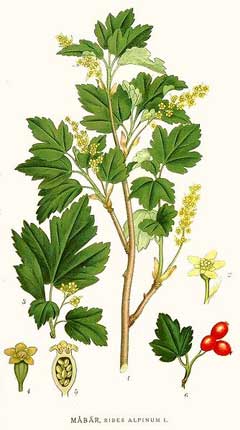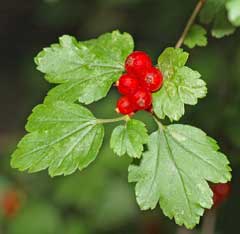 |
|
http://commons.wikimedia.org/wiki/File:282_Ribes_alpinum.jpg |
 |
| http://commons.wikimedia.org/wiki/User:Aka |
Translate this page:
Summary
Bloom Color: Green, Yellow. Main Bloom Time: Early spring, Late spring, Mid spring. Form: Spreading or horizontal, Upright or erect.
Physical Characteristics

 Ribes alpinum is a deciduous Shrub growing to 1.2 m (4ft) by 1 m (3ft 3in) at a medium rate.
Ribes alpinum is a deciduous Shrub growing to 1.2 m (4ft) by 1 m (3ft 3in) at a medium rate.
See above for USDA hardiness. It is hardy to UK zone 2 and is not frost tender. It is in flower from April to May, and the seeds ripen from July to August. The species is dioecious (individual flowers are either male or female, but only one sex is to be found on any one plant so both male and female plants must be grown if seed is required). and is pollinated by Flies, bees. The plant is not self-fertile.
Suitable for: light (sandy), medium (loamy) and heavy (clay) soils, prefers well-drained soil and can grow in nutritionally poor soil. Suitable pH: mildly acid, neutral and basic (mildly alkaline) soils. It can grow in semi-shade (light woodland) or no shade. It prefers moist soil.
UK Hardiness Map
US Hardiness Map
Synonyms
Plant Habitats
Woodland Garden Sunny Edge; Dappled Shade; Ground Cover; Hedge;
Edible Uses
Edible Parts: Fruit
Edible Uses:
Fruit - raw or cooked[105]. Sweet and not very acid, but less palatable than R. rubrum, the red currant[2]. An insipid fruit[100], it is not palatable[1, 11]. The only fruits we have eaten have been good size red currants with a fair flavour[K]. The fruit is about 5mm in diameter and can be freely borne when male and female plants are grown[K].
References More on Edible Uses
Medicinal Uses
Plants For A Future can not take any responsibility for any adverse effects from the use of plants. Always seek advice from a professional before using a plant medicinally.
None known
References More on Medicinal Uses
The Bookshop: Edible Plant Books
Our Latest books on Perennial Plants For Food Forests and Permaculture Gardens in paperback or digital formats.

Edible Tropical Plants
Food Forest Plants for Hotter Conditions: 250+ Plants For Tropical Food Forests & Permaculture Gardens.
More

Edible Temperate Plants
Plants for Your Food Forest: 500 Plants for Temperate Food Forests & Permaculture Gardens.
More

More Books
PFAF have eight books available in paperback and digital formats. Browse the shop for more information.
Shop Now
Other Uses
Hedge Hedge
The cultivar 'Green Mound' makes a good dwarf hedge[182]. Plants can be grown as a tall ground cover when spaced about 2 metres apart each way[208]. The cultivars 'Aureum' and 'Pumilum' are smaller growing and should be spaced about 1 metre apart[208].
Special Uses
Ground cover Hedge Hedge
References More on Other Uses
Cultivation details
Landscape Uses:Erosion control, Foundation, Ground cover, Massing, Rock garden, Seashore. Easily grown in a moisture retentive but well-drained loamy soil of at least moderate quality[11, 200]. This species succeeds on poor soils[11]. Does well in shade though it does not fruit so well in such a position[11]. A very hardy plant, tolerating temperatures down to about -25°c[184]. A number of named varieties have been developed for their ornamental value. The flowers are sweetly fragrant[208]. Plants are dioecious. At least one male plant must be grown in the vicinity of up to 5 females if fruit is required. Plants can harbour a stage of white pine blister rust, so should not be grown in the vicinity of pine trees[155]. Plants in this genus are notably susceptible to honey fungus[200]. Special Features:
Not North American native, Inconspicuous flowers or blooms.
References Carbon Farming Information and Carbon Sequestration Information
Temperature Converter
Type a value in the Celsius field to convert the value to Fahrenheit:
Fahrenheit:
The PFAF Bookshop
Plants For A Future have a number of books available in paperback and digital form. Book titles include Edible Plants, Edible Perennials, Edible Trees,Edible Shrubs, Woodland Gardening, and Temperate Food Forest Plants. Our new book is Food Forest Plants For Hotter Conditions (Tropical and Sub-Tropical).
Shop Now
Plant Propagation
Seed - best sown as soon as it is ripe in the autumn in a cold frame. Stored seed requires 3 months cold stratification at 0 - 9°c and should be sown as early in the year as possible[113, 164]. Under normal storage conditions the seed can remain viable for 17 years or more. Prick out the seedlings into individual pots when they are large enough to handle and grow them on in a cold frame for their first winter, planting them out in late spring of the following year. Cuttings of half-ripe wood, July/August in a frame[113]. Cuttings of mature wood of the current year's growth, preferably with a heel of the previous year's growth, November to February in a cold frame or sheltered bed outdoors[78, 200].
Other Names
If available other names are mentioned here
Adil nouchen, Inalad, Leanykafuge, Mage sostar, Mammuspuu, Naestomari, Planinska ribizla, Qars-momou, Taghmamoucht, Vad ribizli,
Native Range
TEMPERATE ASIA: Turkey (northeast), Russian Federation-Ciscaucasia (Ciscaucasia), Armenia, Georgia EUROPE: Denmark, Finland, United Kingdom, Norway, Sweden, Austria, Switzerland, Czech Republic, Germany, Hungary, Poland, Slovakia, Russian Federation-European part (European part (northwest)), Belarus, Estonia, Lithuania, Latvia, Ukraine, Albania, Bulgaria, Bosnia and Herzegovina, Croatia, Italy, North Macedonia, Montenegro, Romania, Serbia, Slovenia, Spain, France AFRICA: Morocco
Weed Potential
Right plant wrong place. We are currently updating this section.
Please note that a plant may be invasive in one area but may not in your area so it's worth checking.
Conservation Status
IUCN Red List of Threatened Plants Status :

| Related Plants
|
| Latin Name | Common Name | Habit | Height | Hardiness | Growth | Soil | Shade | Moisture | Edible | Medicinal | Other |
| Embelia ribes | False black pepper, White-flowered Embelia | Climber | 15.0 |
10-12
| F | LMH | S | M | 3 | 4 | 2 |
| Rheum ribes | | Perennial | 1.5 |
5-9
| | MH | SN | DM | 2 | 0 | |
| Ribes aciculare | | Shrub | 1.0 |
3-7
| | LMH | SN | M | 3 | 0 | |
| Ribes altissimum | | Shrub | 3.0 |
5-9
| | LMH | SN | M | 3 | 0 | |
| Ribes ambiguum | | Shrub | 0.6 |
5-9
| | LMH | SN | M | 2 | 0 | |
| Ribes americanum | American Blackcurrant | Shrub | 1.8 |
-
| | LMH | SN | M | 2 | 1 | |
| Ribes aureum | Golden Currant | Shrub | 2.4 |
3-8
| F | LMH | SN | DM | 4 | 1 | 2 |
| Ribes bracteosum | Stink Currant | Shrub | 2.5 |
6-9
| | LMH | N | M | 2 | 1 | |
| Ribes burejense | Bureja gooseberry, | Shrub | 1.0 |
4-8
| | LMH | SN | M | 4 | 0 | 0 |
| Ribes californicum | Hillside Gooseberry | Shrub | 0.0 |
6-9
| | LMH | N | M | 2 | 0 | |
| Ribes cereum | Wax Currant | Shrub | 1.8 |
4-8
| | LMH | N | DM | 2 | 1 | |
| Ribes curvatum | Granite gooseberry | Shrub | 1.0 |
6-9
| | LMH | SN | M | 3 | 0 | |
| Ribes cynosbati | Dogberry, Eastern prickly gooseberry | Shrub | 1.5 |
0-0
| | LMH | SN | M | 3 | 1 | 0 |
| Ribes diacanthum | Siberian currant | Shrub | 1.8 |
0-0
| | LMH | SN | M | 2 | 0 | |
| Ribes distans | | Shrub | 0.6 |
4-8
| | LMH | SN | M | 2 | 0 | |
| Ribes divaricatum | Coastal Black Gooseberry, Spreading gooseberry, Parish's gooseberry, Straggly gooseberry | Shrub | 2.7 |
4-8
| | LMH | SN | M | 4 | 1 | 2 |
| Ribes fasciculatum | | Shrub | 1.5 |
4-8
| | LMH | SN | M | 1 | 0 | |
| Ribes fragrans | | Shrub | 0.6 |
3-7
| | LMH | SN | M | 3 | 0 | |
| Ribes gayanum | | Shrub | 1.5 |
7-10
| | LMH | SN | M | 3 | 0 | |
| Ribes glaciale | | Shrub | 3.0 |
-
| | LMH | SN | M | 2 | 0 | |
| Ribes glandulosum | Skunk Currant | Shrub | 0.4 |
-
| | LMH | SN | M | 2 | 1 | 3 |
| Ribes griffithii | | Shrub | 2.5 |
-
| | LMH | SN | M | 2 | 0 | |
| Ribes himalense | | Shrub | 2.0 |
5-9
| | LMH | SN | M | 3 | 1 | |
| Ribes hirtellum | Currant-Gooseberry, Hairystem gooseberry | Shrub | 1.0 |
4-8
| | LMH | N | M | 3 | 0 | 0 |
| Ribes horridum | | Shrub | 1.5 |
-
| | LMH | SN | M | 3 | 0 | |
| Ribes hudsonianum | Hudson Bay Currant, Northern black currant, Western black currant | Shrub | 1.0 |
0-0
| | LMH | SN | M | 2 | 1 | |
| Ribes inebrians | Whisky Currant | Shrub | 2.0 |
4-8
| | LMH | SN | M | 2 | 1 | |
| Ribes inerme | Whitestem Gooseberry, Klamath gooseberry | Shrub | 2.0 |
5-9
| | LMH | SN | M | 2 | 0 | |
| Ribes irriguum | Idaho Gooseberry | Shrub | 3.0 |
-
| | LMH | SN | M | 2 | 1 | |
|
|
Growth: S = slow M = medium F = fast. Soil: L = light (sandy) M = medium H = heavy (clay). pH: A = acid N = neutral B = basic (alkaline). Shade: F = full shade S = semi-shade N = no shade. Moisture: D = dry M = Moist We = wet Wa = water.
Now available:
Food Forest Plants for Mediterranean Conditions
350+ Perennial Plants For Mediterranean and Drier Food Forests and Permaculture Gardens.
[Paperback and eBook]
This is the third in Plants For A Future's series of plant guides for food forests tailored to
specific climate zones. Following volumes on temperate and tropical ecosystems, this book focuses
on species suited to Mediterranean conditions—regions with hot, dry summers and cool, wet winters,
often facing the added challenge of climate change.
Read More
Expert comment
Author
L.
Botanical References
1117200
Links / References
For a list of references used on this page please go here
Readers comment